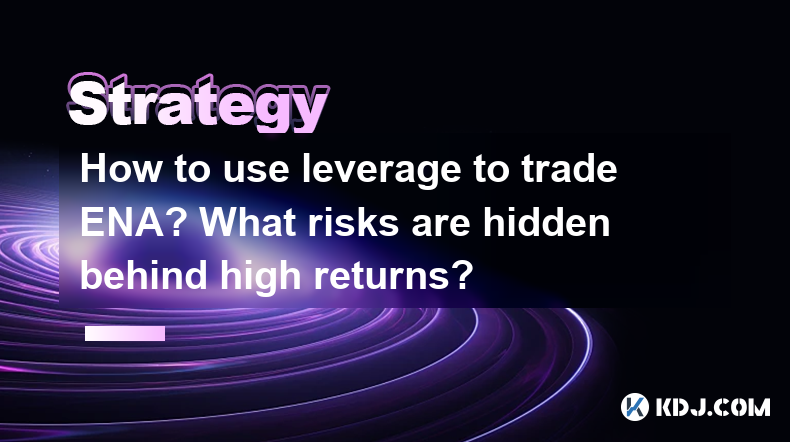-
 bitcoin
bitcoin $124586.364639 USD
0.62% -
 ethereum
ethereum $4670.671710 USD
3.33% -
 xrp
xrp $2.983701 USD
0.18% -
 tether
tether $1.000175 USD
-0.03% -
 bnb
bnb $1209.430642 USD
2.76% -
 solana
solana $231.365861 USD
0.51% -
 usd-coin
usd-coin $0.999665 USD
-0.02% -
 dogecoin
dogecoin $0.264657 USD
4.46% -
 tron
tron $0.346415 USD
1.60% -
 cardano
cardano $0.871586 USD
3.70% -
 chainlink
chainlink $23.451270 USD
7.56% -
 hyperliquid
hyperliquid $46.860071 USD
-2.96% -
 ethena-usde
ethena-usde $1.000120 USD
0.04% -
 sui
sui $3.611279 USD
1.08% -
 stellar
stellar $0.407149 USD
0.96%
How to use leverage to trade ENA? What risks are hidden behind high returns?
Leverage can amplify ENA trading profits but also magnify losses; use stop-loss orders and monitor margin levels to manage risks effectively.
May 06, 2025 at 01:28 pm

Trading ENA with leverage can significantly amplify your potential returns, but it also comes with heightened risks. Leverage allows traders to borrow funds to increase their trading position, which can lead to higher profits if the market moves in their favor. However, if the market moves against them, losses can be equally magnified. In this article, we will explore how to use leverage to trade ENA and delve into the risks that are often hidden behind the allure of high returns.
Understanding Leverage in Cryptocurrency Trading
Leverage in cryptocurrency trading refers to the use of borrowed capital to increase the potential return of an investment. For example, if you use 10x leverage, you can control a position worth 10 times the amount of your initial capital. This means that a small movement in the price of ENA can result in significant profits or losses.
To trade ENA with leverage, you will need to use a cryptocurrency exchange that offers margin trading. Not all exchanges provide this feature, so it's important to choose a platform that supports leveraged trading. Some popular exchanges for margin trading include Binance, Bybit, and Kraken.
Setting Up a Margin Account
Before you can start trading ENA with leverage, you need to set up a margin account on your chosen exchange. Here are the steps to do so:
- Log into your exchange account and navigate to the margin trading section.
- Select the option to open a margin account. This may be labeled as 'Margin Trading' or 'Futures Trading,' depending on the platform.
- Deposit funds into your margin account. You will need to deposit a certain amount of cryptocurrency or fiat currency as collateral.
- Choose the leverage level you want to use. Most exchanges offer various leverage options, such as 2x, 5x, 10x, or even higher.
Placing a Leveraged Trade on ENA
Once your margin account is set up, you can place a leveraged trade on ENA. Here's how to do it:
- Navigate to the trading interface for ENA on your exchange. This could be in the spot trading or futures trading section, depending on the exchange.
- Select the trading pair that includes ENA. For example, if you want to trade ENA against Bitcoin, you would select the ENA/BTC pair.
- Choose the order type. You can place a market order, which will execute immediately at the current market price, or a limit order, which will execute only if the price reaches your specified level.
- Enter the amount you want to trade. This will be the amount of ENA you want to buy or sell, multiplied by the leverage you are using.
- Review and confirm the order. Make sure you understand the potential risks and rewards before confirming the trade.
Monitoring and Managing Your Leveraged Position
After placing a leveraged trade on ENA, it's crucial to monitor your position closely. Cryptocurrency markets can be highly volatile, and prices can change rapidly. Here are some tips for managing your leveraged position:
- Set stop-loss orders to limit potential losses. A stop-loss order will automatically close your position if the price of ENA moves against you by a certain amount.
- Keep an eye on your margin level. If the price of ENA moves against you, your margin level may decrease, potentially leading to a margin call. A margin call occurs when your account balance falls below the required maintenance margin, and you may be required to deposit additional funds or close your position.
- Regularly review your position and adjust your strategy as needed. If the market conditions change, you may need to adjust your leverage level or close your position to minimize risk.
Risks Associated with Leveraged Trading
While leveraged trading can offer the potential for high returns, it also comes with significant risks. Here are some of the key risks to be aware of:
- Amplified losses: Just as leverage can amplify your profits, it can also amplify your losses. If the price of ENA moves against you, you could lose more than your initial investment.
- Liquidation risk: If the price of ENA moves against you and your margin level falls below the required maintenance margin, your position may be liquidated. This means that the exchange will automatically close your position to prevent further losses, and you could lose your entire investment.
- Market volatility: Cryptocurrency markets are known for their high volatility, which can lead to rapid price movements. This can be particularly dangerous when trading with leverage, as even small price movements can result in significant losses.
- Interest and fees: When you trade with leverage, you are essentially borrowing funds from the exchange. This means you will need to pay interest on the borrowed amount, as well as any trading fees associated with your position. These costs can eat into your potential profits.
Psychological Risks of Leveraged Trading
In addition to the financial risks, leveraged trading can also have psychological impacts. Here are some of the psychological risks to be aware of:
- Overconfidence: The potential for high returns can lead to overconfidence, causing traders to take on more risk than they can handle. This can result in significant losses if the market moves against them.
- Emotional decision-making: The high stakes of leveraged trading can lead to emotional decision-making, such as holding onto a losing position in the hope that it will recover or closing a winning position too early out of fear.
- Stress and anxiety: The constant monitoring and management required for leveraged trading can lead to increased stress and anxiety, which can negatively impact your overall well-being and trading performance.
Frequently Asked Questions
Q: Can I use leverage to trade ENA on any cryptocurrency exchange?A: No, not all cryptocurrency exchanges offer margin trading or leveraged trading. You will need to choose an exchange that supports these features, such as Binance, Bybit, or Kraken.
Q: What is the difference between spot trading and margin trading?A: Spot trading involves buying and selling assets at the current market price without using borrowed funds. Margin trading, on the other hand, allows you to borrow funds to increase your trading position, which can amplify both your potential profits and losses.
Q: How can I reduce the risks associated with leveraged trading?A: To reduce the risks of leveraged trading, you can use stop-loss orders to limit potential losses, keep an eye on your margin level to avoid liquidation, and regularly review and adjust your position based on market conditions. It's also important to only trade with funds you can afford to lose and to avoid over-leveraging your positions.
Q: Is it possible to trade ENA with leverage without using a margin account?A: No, to trade ENA with leverage, you will need to use a margin account on a cryptocurrency exchange that supports margin trading. This allows you to borrow funds to increase your trading position.
Disclaimer:info@kdj.com
The information provided is not trading advice. kdj.com does not assume any responsibility for any investments made based on the information provided in this article. Cryptocurrencies are highly volatile and it is highly recommended that you invest with caution after thorough research!
If you believe that the content used on this website infringes your copyright, please contact us immediately (info@kdj.com) and we will delete it promptly.
- BlockDAG, DOGE, HYPE Sponsorship: Crypto Trends Shaping 2025
- 2025-10-01 00:25:13
- Deutsche Börse and Circle: A StableCoin Adoption Powerhouse in Europe
- 2025-10-01 00:25:13
- BlockDAG's Presale Buzz: Is It the Crypto to Watch in October 2025?
- 2025-10-01 00:30:13
- Bitcoin, Crypto, and IQ: When Genius Meets Digital Gold?
- 2025-10-01 00:30:13
- Stablecoins, American Innovation, and Wallet Tokens: The Next Frontier
- 2025-10-01 00:35:12
- NBU, Coins, and Crypto in Ukraine: A New Yorker's Take
- 2025-10-01 00:45:14
Related knowledge

Practical parameter settings for a Bitcoin multi-timeframe moving average system
Sep 18,2025 at 10:54pm
Optimizing Timeframe Combinations for Bitcoin Trading1. Selecting appropriate timeframes is crucial when building a multi-timeframe moving average sys...

How can I filter out false breakouts in Dogecoin high-frequency trading?
Sep 22,2025 at 01:00am
Understanding False Breakouts in Dogecoin Trading1. A false breakout occurs when Dogecoin's price appears to move beyond a defined support or resistan...

Techniques for identifying tops and bottoms in the Bitcoin on-chain NVT model
Sep 20,2025 at 07:54pm
Understanding the NVT Model in Bitcoin Analysis1. The Network Value to Transactions (NVT) ratio is often described as the 'P/E ratio' of the cryptocur...

What does the surge in open interest in Bitcoincoin futures mean?
Sep 20,2025 at 11:18pm
Understanding the Surge in Dogecoin Futures Open Interest1. A surge in open interest within Dogecoin futures indicates a growing number of active cont...

How can I use the Ethereum USDT premium to gauge market sentiment?
Sep 18,2025 at 11:55pm
Understanding the Ethereum USDT Premium1. The Ethereum USDT premium refers to the price difference between USDT (Tether) traded on Ethereum-based plat...

What should I do if Ethereum staking yields decline?
Sep 20,2025 at 06:18am
Understanding the Causes Behind Declining Ethereum Staking Yields1. The Ethereum network transitioned to a proof-of-stake consensus mechanism with the...

Practical parameter settings for a Bitcoin multi-timeframe moving average system
Sep 18,2025 at 10:54pm
Optimizing Timeframe Combinations for Bitcoin Trading1. Selecting appropriate timeframes is crucial when building a multi-timeframe moving average sys...

How can I filter out false breakouts in Dogecoin high-frequency trading?
Sep 22,2025 at 01:00am
Understanding False Breakouts in Dogecoin Trading1. A false breakout occurs when Dogecoin's price appears to move beyond a defined support or resistan...

Techniques for identifying tops and bottoms in the Bitcoin on-chain NVT model
Sep 20,2025 at 07:54pm
Understanding the NVT Model in Bitcoin Analysis1. The Network Value to Transactions (NVT) ratio is often described as the 'P/E ratio' of the cryptocur...

What does the surge in open interest in Bitcoincoin futures mean?
Sep 20,2025 at 11:18pm
Understanding the Surge in Dogecoin Futures Open Interest1. A surge in open interest within Dogecoin futures indicates a growing number of active cont...

How can I use the Ethereum USDT premium to gauge market sentiment?
Sep 18,2025 at 11:55pm
Understanding the Ethereum USDT Premium1. The Ethereum USDT premium refers to the price difference between USDT (Tether) traded on Ethereum-based plat...

What should I do if Ethereum staking yields decline?
Sep 20,2025 at 06:18am
Understanding the Causes Behind Declining Ethereum Staking Yields1. The Ethereum network transitioned to a proof-of-stake consensus mechanism with the...
See all articles










































































